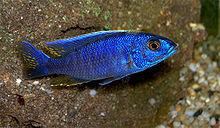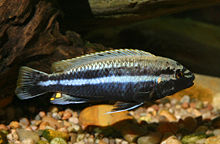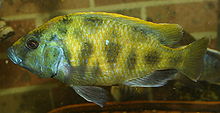- Haplochromis
-
Haplochromis 
Haplochromis thereuterion Scientific classification Kingdom: Animalia Phylum: Chordata Subphylum: Vertebrata Superclass: Osteichthyes Class: Actinopterygii Subclass: Neopterygii Infraclass: Teleostei Superorder: Acanthopterygii Order: Perciformes Family: Cichlidae Subfamily: Pseudocrenilabrinae Tribe: Haplochromini Genus: Haplochromis
Hilgendorf, 1888Type species Chromis obliquidens
Hilgendorf, 1888Diversity About 220 species Synonyms Many, see text
Haplochromis is a ray-finned fish genus in the family Cichlidae. It has been used as the default "wastebin taxon" for Pseudocrenilabrinae cichlids of the East African Rift, and as such became the "largest" fish "genus". Many of these cichlids are popular aquarium fishes; like similar Haplochromini they are known as "haplos", "happies" or "haps" among aquarium enthusiasts.[1]
The genus was established by F.M. Hilgendorf in 1888. It was originally conceived as a subgenus of A.C.L.G. Günther's "Chromis", at that time an even larger "wastebin genus" for Pseudocrenilabrinae cichlids. The type species of Hilgendorf was H. obliquidens. "Chromis" of Günther turned out to be a junior homonym of G. Cuvier's ocean fish genus Chromis, established in 1814 already, and was abolished. As the years went by, other genera of (mostly) Haplochromini were lumped with and split again from Haplochromis, and the final delimitation of the clade around H. obliquidens is not yet done.
Contents
Extinction crisis in Lake Victoria
The introduction of Nile Perch (Lates niloticus) to Lake Victoria after 1954 severely upset the lake's ecosystem. By the late 1970s, the perch's population was approaching carrying capacity, and the smaller cichlids were fair game for the huge carnivorous Lates, The Nile Tilapia (Oreochromis niloticus), an adaptable generalist, was also introduced and competed with the often specialized endemic cichlids of the lake for food and other resources. When the Nile Perch stocks finally declined again in the late 1980s, an estimated 200 Haplochromini species (mostly Haplochromis) had become extinct – many of these had only been scientifically described a few years before their demise, and additional ones were only known or suspected to exist, but never properly studied or described.[2]
While the stocks of those species that survived are in many cases recovering, the lake ecosystem has changed irrevocably. It is being observed that the entire trophic web has been upset. But still, evolution runs its course: those Lake Victoria Haplochromis that still exist are in many cases adapting to new food sources, and in time speciation is likely to set in and produce a new adaptive radiation of these fishes. Until then, however, the ecological balance of the lake is still on the brink, and many of the cichlids that survived the peak population of Lates are still Critically Endangered and close to extinction.[3]
Systematics and taxonomy
Haplochromis is the type genus of the tribe Haplochromini. Most of the tribe's members were at one time or another included in the present genus, but in many cases this was only temporary. Around the year 1900 as well 100 years later, there was a trend to split up the genus; especially in the mid-20th century on the other hand, most authors lumped any and all Haplochromini that were not conspicuously distinct in the type genus.[4]
While a number of African Rift Valley ciclids are certainly very close relatives of H. obliquidens, the type species of the present genus, it is not very clear where to draw the boundary of Haplochromis with regard to its relatives. Still, several genera are nowadays recognized as distinct by many authors and scientific databases such as FishBase (see below); in particular the Haplochromini from Lake Tanganyika and Lake Malawi are usually removed form Haplochromis. The genus delimitation in the entire tribe remains badly resolved however, and further changes in taxonomy are likely in the future. In particular between Haplochromis, Astatotilapia and Thoracochromis, species have been moved to and fro over the years. The habit of Pseudocrenilabrinae to hybridize is hampering molecular phylogenetic studies based on mtDNA alone, while trophic morphs of a single species may appear to be distinct "species" if they are not phylogenetically studied. Several proposed genera are again included in Haplochromis at present, but it cannot be ruled out that some of these will eventually be recognized as valid again.[5]
Species
As of 2009, FishBase places about 220 species in Haplochromis. In addition, there are distinct several populations known which probably represent additional species (see below). The species list here follows FishBase, except for recognizing Pundamilia as distinct:[6]
- Haplochromis acidens
- Haplochromis adolphifrederici (Boulenger, 1914)
- Haplochromis aelocephalus
- Haplochromis aeneocolor
- Haplochromis akika Lippitsch, 2003
- Haplochromis albertianus Regan, 1929
- Haplochromis altigenis Regan, 1922
- Haplochromis ampullarostratus Schraml, 2004
- Haplochromis angustifrons
- Haplochromis annectidens
- Haplochromis antleter Mietes & Witte, 2010[7]
- Haplochromis apogonoides Greenwood, 1967
- Haplochromis arcanus (extinct)
- Haplochromis argenteus
- Haplochromis artaxerxes (extinct)
- Haplochromis astatodon Regan, 1921
- Haplochromis avium Regan, 1929
- Haplochromis barbarae
- Haplochromis bareli van Oijen, 1991
- Haplochromis bartoni (extinct)
- Haplochromis bayoni
- Haplochromis beadlei Trewavas, 1933
- Haplochromis bloyeti Boulenger, 1906
- Haplochromis boops (extinct)
- Haplochromis brownae
- Haplochromis bullatus Trewavas, 1938
- Haplochromis bwathondii Niemantsverdriet & Witte, 2010[7]
- Haplochromis cassius (extinct)
- Haplochromis cavifrons
- Haplochromis chilotes
- Haplochromis chlorochrous Greenwood & Gee, 1969
- Haplochromis chromogynos
- Haplochromis chrysogynaion van Oijen, 1991
- Haplochromis cinctus Greenwood & Gee, 1969
- Haplochromis cinereus (Boulenger, 1906)
- Haplochromis cnester Witte & Witte-Maas, 1981
- Haplochromis commutabilis Schraml, 2004 – Kachira Blue
- Haplochromis coprologus Niemantsverdriet & Witte, 2010[7]
- Haplochromis crassilabris Boulenger, 1906
- Haplochromis crebridens
- Haplochromis crocopeplus Greenwood & Barel, 1978
- Haplochromis cronus Greenwood, 1959
- Haplochromis cryptodon
- Haplochromis cryptogramma Greenwood & Gee, 1969
- Haplochromis cyaneus
- Haplochromis decticostoma (extinct)
- Haplochromis degeni (extinct in the wild)
- Haplochromis dentex (extinct)
- Haplochromis desfontainii
- Haplochromis dichrourus Regan, 1922
- Haplochromis diplotaenia Regan & Trewavas, 1928
- Haplochromis dolichorhynchus Greenwood & Gee, 1969
- Haplochromis dolorosus Trewavas, 1933
- Haplochromis eduardianus
- Haplochromis eduardii Regan, 1921
- Haplochromis elegans
- Haplochromis empodisma Greenwood, 1960
- Haplochromis engystoma Trewavas, 1933
- Haplochromis erythrocephalus Greenwood & Gee, 1969
- Haplochromis erythromaculatus
- Haplochromis estor (extinct)
- Haplochromis eutaenia Regan & Trewavas, 1928
- Haplochromis exspectatus Schraml, 2004
- Haplochromis fischeri Seegers, 2008
- Haplochromis flavipinnis (extinct)
- Haplochromis flavus
- Haplochromis fuelleborni (Hilgendorf & Pappenheim, 1903) – Fuelleborn's Mouthbrooder
- Haplochromis fuscus Regan, 1925
- Haplochromis fusiformis Greenwood & Gee, 1969
- Haplochromis gigas (Seehausen & Lippitsch, 1998)
- Haplochromis gigliolii (Pfeffer, 1896)
- Haplochromis gilberti
- Haplochromis gowersii (extinct)
- Haplochromis gracilior – Torpedostripe Haplochromis
- Haplochromis granti
- Haplochromis graueri
- Haplochromis greenwoodi (Seehausen & Bouton, 1998)
- Haplochromis guiarti
- Haplochromis harpakteridion van Oijen, 1991
- Haplochromis heusinkveldi
- Haplochromis hiatus Hoogerhoud & Witte, 1981
- Haplochromis howesi
- Haplochromis humilior (Boulenger, 1911)
- Haplochromis humilis (Steindachner, 1866)
- Haplochromis insidiae
- Haplochromis iris Hoogerhoud & Witte, 1981
- Haplochromis ishmaeli (extinct in the wild)
- Haplochromis kamiranzovu
- Haplochromis katavi – Katavi Mouthbrooder
- Haplochromis katunzii ter Huurne & Witte, 2010[7]
- Haplochromis kujunjui van Oijen, 1991
- Haplochromis labiatus
- Haplochromis labriformis (Nichols & La Monte, 1938)
- Haplochromis lacrimosus (Boulenger, 1906)
- Haplochromis laparogramma
- Haplochromis latifasciatus
- Haplochromis limax
- Haplochromis lividus (extinct in the wild)
- Haplochromis loati Greenwood, 1971
- Haplochromis longirostris (extinct)
- Haplochromis luteus (Seehausen & Bouton, 1998)
- Haplochromis macconneli
- Haplochromis macrognathus (extinct)
- Haplochromis macrops (Boulenger, 1911)
- Haplochromis macropsoides
- Haplochromis maculipinna
- Haplochromis mahagiensis David & Poll, 1937
- Haplochromis maisomei van Oijen, 1991
- Haplochromis malacophagus Poll & Damas, 1939
- Haplochromis mandibularis (extinct)
- Haplochromis martini (extinct)
- Haplochromis maxillaris
- Haplochromis mbipi (Lippitsch & Bouton, 1998)
- Haplochromis megalops
- Haplochromis melanopterus
- Haplochromis melanopus Regan, 1922
- Haplochromis melichrous Greenwood & Gee, 1969
- Haplochromis mentatus Regan, 1925
- Haplochromis mento
- Haplochromis michaeli
- Haplochromis microchrysomelas
- Haplochromis microdon
- Haplochromis multiocellatus (Pellegrin, 1913)
- Haplochromis murakoze Coenen, Snoeks & Thys van den Audenaerde, 1984
- Haplochromis mylergates (extinct)
- Haplochromis mylodon
- Haplochromis nanoserranus (extinct)
- Haplochromis nigrescens (extinct)
- Haplochromis nigricans (Boulenger, 1906)
- Haplochromis nigripinnis
- Haplochromis nigroides
- Haplochromis niloticus Greenwood, 1960
- Haplochromis nubilus – Blue Victoria Mouthbrooder
- Haplochromis nuchisquamulatus
- Haplochromis nyanzae (extinct)
- Haplochromis obesus (Boulenger, 1906)
- Haplochromis obliquidens
- Haplochromis obtusidens (extinct)
- Haplochromis occultidens
- Haplochromis oligolepis Lippitsch, 2003
- Haplochromis olivaceus
- Haplochromis omnicaeruleus (Seehausen & Bouton, 1998)
- Haplochromis oregosoma
- Haplochromis orthostoma Regan, 1922
- Haplochromis pachycephalus (extinct)
- Haplochromis pallidus (Boulenger, 1911)
- Haplochromis paludinosus
- Haplochromis pancitrinus Mietes & Witte, 2010[7]
- Haplochromis pappenheimi
- Haplochromis paradoxus (Lippitsch & Kaufman, 2003)
- Haplochromis paraguiarti (extinct)
- Haplochromis paraplagiostoma (extinct)
- Haplochromis paropius
- Haplochromis parorthostoma Greenwood, 1967
- Haplochromis parvidens (Boulenger, 1911)
- Haplochromis paucidens
- Haplochromis pellegrini Regan, 1922
- Haplochromis percoides (extinct)
- Haplochromis perrieri (extinct in the wild)
- Haplochromis petronius
- Haplochromis pharyngalis Poll & Damas, 1939
- Haplochromis pharyngomylus (extinct)
- Haplochromis phytophagus
- Haplochromis piceatus
- Haplochromis pitmani Fowler, 1936
- Haplochromis placodus Poll & Damas, 1939
- Haplochromis plagiodon
- Haplochromis plagiostoma
- Haplochromis plutonius Greenwood & Barel, 1978
- Haplochromis prodromus Trewavas, 1935
- Haplochromis prognathus (extinct)
- Haplochromis pseudopellegrini (extinct)
- Haplochromis ptistes Greenwood & Barel, 1978
- Haplochromis pyrrhocephalus
- Haplochromis pyrrhopteryx van Oijen, 1991
- Haplochromis retrodens (Hilgendorf, 1888)
- Haplochromis riponianus
- Haplochromis rubescens
- Haplochromis rubripinnis (Seehausen, Lippitsch & Bouton, 1998)
- Haplochromis rudolfianus
- Haplochromis rufocaudalis (Seehausen & Bouton, 1998)
- Haplochromis rufus (Seehausen & Lippitsch, 1998)
- Haplochromis sauvagei
- Haplochromis saxicola
- Haplochromis scheffersi
- Haplochromis schubotzi
- Haplochromis schubotziellus
- Haplochromis serranus
- Haplochromis serridens Regan, 1925
- Haplochromis simotes (Boulenger, 1911)
- Haplochromis simpsoni
- Haplochromis smithii (Castelnau, 1861)
- Haplochromis snoeksi Wamuini Lunkayilakio & Vreven, 2010[8]
- Haplochromis spekii
- Haplochromis sphex ter Huurne & Witte, 2010[7]
- Haplochromis squamipinnis
- Haplochromis squamulatus Regan, 1922
- Haplochromis sulphureus Greenwood & Barel, 1978
- Haplochromis tanaos van Oijen & Witte, 1996
- Haplochromis taurinus
- Haplochromis teegelaari (extinct)
- Haplochromis teunisrasi Witte & Witte-Maas, 1981
- Haplochromis theliodon Greenwood, 1960
- Haplochromis thereuterion van Oijen & Witte, 1996
- Haplochromis thuragnathus (extinct)
- Haplochromis tridens Regan & Trewavas, 1928
- Haplochromis turkanae – Turkana Haplochromis
- Haplochromis tyrianthinus Greenwood & Gee, 1969
- Haplochromis ushindi van Oijen, 2004
- Haplochromis vanoijeni de Zeeuw & Witte, 2010[7]
- Haplochromis velifer
- Haplochromis venator
- Haplochromis vicarius Trewavas, 1933
- Haplochromis victoriae (Greenwood, 1956)
- Haplochromis victorianus
- Haplochromis vittatus
- Haplochromis vonlinnei van Oijen & de Zeeuw, 2008
- Haplochromis welcommei
- Haplochromis worthingtoni
- Haplochromis xanthopteryx (Seehausen & Bouton, 1998)
- Haplochromis xenognathus
- Haplochromis xenostoma (extinct)
Undescribed species
These populations are typically referred to by the names they have in the aquarium fish trade. A number of them is likely to represent undescribed distinct species; others might just be subspecies or color morphs. Whether they all belong in Haplochromis is, of course, doubtful. Some of these populations are:
- Haplochromis aff. bloyeti[verification needed]
- sp. 'argens'[verification needed]
Formerly in Haplochromis
 Adult male Sciaenochromis fryeri
Adult male Sciaenochromis fryeri
Among other genera of Haplochromini that were formerly included here, many are small or monotypic. The distinctness of these is highly doubtful, as they may just be distinct lineages of Haplochromis or other haplochromines. That nonwithstanding, Haplochromini genera to which some former "Haplochromis" have been removed are in particular:[9]
- Astatoreochromis (3 species)
- Astatotilapia (8 described species)
- Aulonocara (22 species)
- Buccochromis (7 species)
- Caprichromis (2 species)
- Champsochromis (2 species)
- Cheilochromis (monotypic)
- Chetia (6 species)
- Copadichromis (25 described species)
- Ctenochromis (5 living and 1 extinct described species)
- Ctenopharynx (3 species)
- Cyrtocara (monotypic)
- Dimidiochromis (4 species)
- Eclectochromis (2 species)
- Fossorochromis (monotypic)
- Hemitaeniochromis (monotypic)
- Lethrinops (24 species)
- Maylandia/Metriaclima (25 species)
- Mchenga (6 species)
- Melanochromis (27 species)
- Mylochromis (21 species)
- Naevochromis (monotypic)
- Nimbochromis (5 species)
- Nyassachromis (8 species)
- Orthochromis (14 species)
- Otopharynx (13 species)
- Pharyngochromis (2 species)
- Placidochromis (43 species)
- Protomelas (15 species)
- Pundamilia (4 species)
- Pseudocrenilabrus (3 species)
- Sargochromis (8 species)
- Schwetzochromis (monotypic)
- Sciaenochromis (4 species)
- Stigmatochromis (4 species)
- Taeniochromis (monotypic)
- Taeniolethrinops (4 species)
- Thoracochromis (12 species)
- Tramitichromis (5 species)
- Trematocranus (3 species)
- Tyrannochromis (4 species)
Some other Pseudocrenilabrinae were also – mainly by early authors – included in Haplochromis, even though they are not members of its tribe. These are:[4]
- Anomalochromis thomasi of the Hemichromini
- Altolamprologus compressiceps of the Lamprologini
- Tilapia jallae of the Tilapiini
Synonyms of Haplochromis
With all the taxonomic and systematic confusion affecting Haplochromis and its allies, it is hardly surprising that the genus has a large number of junior synonyms. Most referred to small or monotypic genera that were once considered distinct, but are nowadays included in Haplochromis again, if only to wait for a major review of their status. Synonyms are:
- Allochromis Greenwood, 1980
- Cleptochromis Greenwood, 1980
- Enterochromis Greenwood, 1980
- Gaurochromis Greenwood, 1980
- Harpagochromis Greenwood, 1980
- Labrochromis Regan, 1920
- Lipochromis Regan, 1920
- Platytaeniodus Boulenger, 1906
- Prognathochromis Greenwood, 1980
- Ptyochromis Greenwood, 1980
- Psammochromis Greenwood, 1980
- Tridontochromis Greenwood, 1980
- Xystichromis Greenwood, 1980
- Yssichromis Greenwood, 1980
and sometimes other genera listed above are also synonymized.
Footnotes
- ^ Linke & Staeck (1994)
- ^ Linke & Staeck (1994), Kishe-Machumu et al. (2008), IUCN (2009)
- ^ Kishe-Machumu et al. (2008), IUCN (2009)
- ^ a b FishBase [2009b]
- ^ Nagl et al. (2001), FishBase [2009b]
- ^ FishBase [2009a]
- ^ a b c d e f g de Zeeuw; Mietes, Niemantsverdriet, ter Huurne & Witte (2010). "Seven new species of detritivorous and phytoplanktivorous haplochromines from Lake Victoria". Zoologische Medelingen Leiden 84: 201–250. http://www.repository.naturalis.nl/document/191025.
- ^ Wamuini Lunkayilakio; Vreven (2010). "‘Haplochromis’ snoeksi, a new species from the Inkisi River basin, Lower Congo (Perciformes: Cichlidae)". Ichthyological Exploration of Freshwaters 21 (3): 279–287. http://www.pfeil-verlag.de/04biol/pdf/ief21_3_08.pdf.
- ^ Linke & Staeck (1994), FishBase [2009b]
References
- FishBase [2009a]: Valid Haplochromis species. Retrieved 2009-OCT-03.
- FishBase [2009b]: Haplochromis taxa. Retrieved 2009-OCT-03.
- International Union for the Conservation of Nature and Natural Resources (IUCN) (2009): 2009 IUCN Red List of Threatened Species. Version 2009.1. Retrieved 2009-SEP-20.
- Kishe-Machumu, Mary; Witte,Frans & Wanink, Jan H. (2008): Dietary shift in benthivorous cichlids after the ecological changes in Lake Victoria. Anim. Biol. 58(4): 401-417. doi:10.1163/157075608X383700 (HTML abstract)
- Linke, H. & Staeck, L. (1994): African cichlids II: Cichlids from East Africa. A handbook for their identification, care and breeding. Tetra Press, Germany. ISBN 1-56465-167-3
- Nagl, Sandra; Tichy, Herbert; Mayer, Werner E.; Samonte, Irene E.; McAndrew, Brendan J. & Klein, Jan (2001): Classification and Phylogenetic Relationships of African Tilapiine Fishes Inferred from Mitochondrial DNA Sequences. Molecular Phylogenetics and Evolution 20(3): 361–374. doi:10.1006/mpev.2001.0979
Categories:- Haplochromis
- Fish of Africa
Wikimedia Foundation. 2010.


